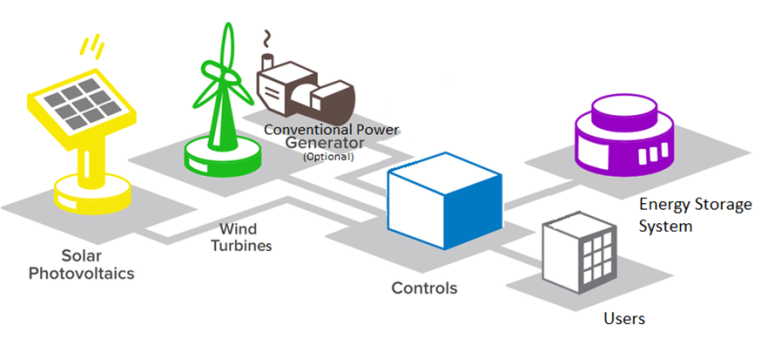As the demand for sustainable energy solutions grows, the integration of renewable energy microgrids is becoming increasingly important. These systems provide localized power generation, enhancing energy security and reducing reliance on fossil fuels. Central to the effectiveness of microgrids is energy storage, and lithium batteries have emerged as a leading option due to their efficiency, versatility, and performance characteristics. This article explores the integration of lithium batteries in renewable energy microgrids, highlighting their benefits, challenges, and best practices.
Understanding Microgrids
Microgrids are localized energy systems that can operate independently or in conjunction with the traditional grid. They typically combine various renewable energy sources, such as solar panels, wind turbines, and hydropower, with energy storage solutions to optimize energy production and consumption. By decentralizing energy generation, microgrids enhance resilience against outages and provide more reliable power to local communities.

The Role of Lithium Batteries
Lithium batteries, particularly lithium-ion and lithium iron phosphate (LiFePO4), have become the preferred energy storage solution for renewable energy microgrids. Their high energy density, long cycle life, and low maintenance requirements make them ideal for applications where space and reliability are critical.
Key Benefits of Lithium Batteries in Microgrids
- High Energy Density: Lithium batteries offer a greater amount of energy storage per unit of weight compared to traditional lead-acid batteries. This characteristic allows for more compact installations and increased capacity in limited spaces.
- Fast Charging and Discharging: Lithium batteries can charge and discharge at a much faster rate than other battery technologies, enabling quick responses to fluctuations in energy demand and supply. This capability is vital for maintaining grid stability in microgrids.
- Long Lifespan: Lithium batteries have a longer cycle life, often exceeding 2,000 cycles under optimal conditions. This longevity translates to lower replacement costs and reduced environmental impact over time.
- Temperature Tolerance: Many lithium battery chemistries perform well in a wide range of temperatures, making them suitable for diverse climatic conditions. This adaptability is crucial for microgrids deployed in various geographical locations.
- Low Maintenance: Unlike traditional batteries that require regular maintenance, lithium batteries are largely maintenance-free. This feature reduces operational costs and simplifies management for microgrid operators.
Challenges in Integration
While lithium batteries offer numerous advantages, several challenges must be addressed for effective integration into renewable energy microgrids:
- Initial Cost: The upfront cost of lithium batteries can be higher than other storage technologies. However, the total cost of ownership may be lower due to their longevity and efficiency.
- Safety Concerns: Lithium batteries can pose safety risks if not managed properly. Thermal runaway, which can lead to overheating and fires, must be mitigated through proper battery management systems (BMS) and safety protocols.
- Recycling and End-of-Life Management: As the use of lithium batteries increases, so does the need for sustainable recycling and disposal methods. Developing efficient recycling systems is essential to minimize environmental impact.
- Grid Compatibility: Integrating lithium batteries into existing grid infrastructure can present compatibility challenges. Ensuring seamless communication and operation between battery systems and other components of the microgrid is vital for optimal performance.
Best Practices for Integration
To maximize the benefits of lithium batteries in renewable energy microgrids, several best practices should be considered:
- Optimal Sizing and Design: Careful planning and modeling are essential for determining the appropriate size and configuration of lithium battery systems. This process should account for energy demand, generation capacity, and storage requirements.
- Implement Advanced Battery Management Systems (BMS): A robust BMS can monitor battery health, optimize charging and discharging cycles, and enhance safety. Implementing advanced algorithms can improve the efficiency and longevity of lithium battery systems.
- Regular Monitoring and Maintenance: Although lithium batteries require less maintenance than other technologies, regular monitoring is crucial to ensure optimal performance. Tracking battery metrics, such as state of charge (SOC) and state of health (SOH), can help identify potential issues before they escalate.
- Utilize Hybrid Systems: Combining lithium batteries with other energy storage technologies, such as supercapacitors or flywheels, can enhance overall system performance. Hybrid systems can leverage the strengths of each technology, providing a more flexible and efficient energy storage solution.
- Focus on Safety Protocols: Implementing safety protocols and training personnel in proper handling and emergency response procedures is essential to mitigate risks associated with lithium batteries. This includes establishing clear guidelines for installation, operation, and maintenance.
Conclusion
Integrating lithium batteries into renewable energy microgrids presents a significant opportunity to enhance energy storage, improve reliability, and promote sustainability. While challenges exist, the advantages of lithium technology—such as high energy density, fast charging, and low maintenance—make it an attractive choice for modern microgrid applications. By adhering to best practices and addressing potential risks, operators can create resilient, efficient, and sustainable microgrids that contribute to the transition toward a cleaner energy future. As technology continues to evolve, the role of lithium batteries in renewable energy systems will undoubtedly expand, paving the way for innovative energy solutions.

